Microsoft delivers beta of 'Xdrive' tool for moving Windows apps to the Azure cloud

Microsoft is making available to testers a beta of Windows Azure Drive (formerly known as XDrive), which will allow them to create automatic backups of Windows applications that they may want to move to the Azure cloud.
Microsoft officials said in November 2009 at the Professional Developers Conference PDC) that they expected to turn on XDrive in January 2010. That beta went live this week.
In a February 2 blog post to the Windows Azure Team Blog, Director/Architect of Windows Azure Storage Brad Calder explained how the new Windows Azure Drive capability will work. From his overview:
"Customers have told us that they want to take their already running Windows applications and run them in the cloud using the standard Windows NTFS APIs (application programming interfaces), and make sure that the data is durable. With Windows Azure Drive, your Windows Azure applications running in the cloud can use existing NTFS APIs to access a durable drive. This can significantly ease the migration of existing Windows applications to the cloud, enabling customers a more seamless migration experience while simultaneously reducing the amount of time it takes to move their applications from your own Windows environment to a Windows Azure environment."
The subsequently created Windows Azure application can read from or write to a drive letter representing a durable NTFS volume for storing and accessing data. That drive is a Windows Azure Page Blob containing an NTFS-formatted Virtual Hard Drive (VHD), he said.
To test the new capability, developers need the just-released February 2010 of the Windows Azure software development kit, which includes the Windows Azure Drive APIs. They'll also need Windows Azure Guest OS 1.1. Microsoft is going to charge testers during the beta, according to Calder's post. He said customers will be billed "only for the storage space used by the Page Blob and the read/write transactions to the Page Blob." They'll be charged at "the standard Windows Azure usage rates," and there won't be a separate line item on their bills, he said.
There's a Microsoft white paper that provides a broader overview of Windows Azure Drive and Microsoft's overall storage strategy for Windows Azure.
There's no word in Calder's post as to when Microsoft expects to release the final version of Windows Azure Drive. I've asked to see whether Microsoft officials will say. Update: They are saying they "don't have any specific details to share" as to when Windows Azure Drive will go final, a spokesperson said.
Here are some of the other "coming soon" Azure deliverables that Microsoft officials touted at the November 2009 PDC:
Microsoft announced general availability of Azure on February 1, as is charging customers, as of February 2, for using its cloud infrastructure/service.
